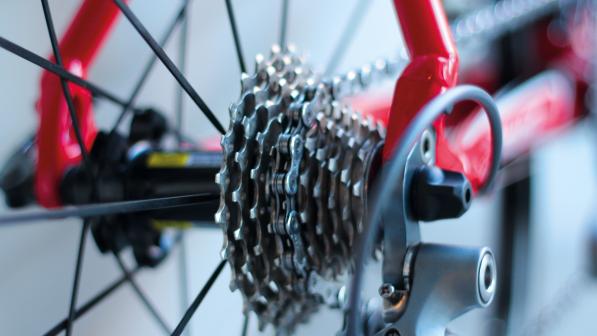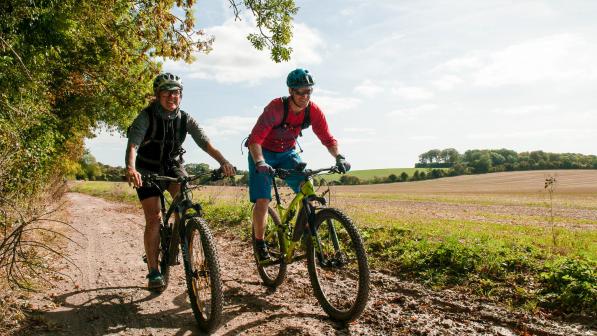A beginners’ guide to … wheels on a cycle

The wheels on your bike go round and round – propelling you along. A cycle’s wheels are its point of contact with the ground, providing traction to move you forward, transmitting any lumps and bumps through the cycle and into your hands and feet and taking your weight.
The wheels support your weight and enable smooth cycling by rolling on a variety of surfaces. They work by converting the rider’s pedalling force into forward motion through their rotation, facilitated by the interaction of the four main wheel components – hub, spokes, rim and tyre. They are, in short, essential to the use and comfort of a bike.
There are many different types of cycle wheel, depending on the type of cycling you do, the terrain, the bike’s setup and so on. Learning a bit more about the different parts of a wheel, what they do and the options will ensure you get the right wheel for you.
This article looks at standard cycle wheels. Cargo, folding and non-standard cycles will all have different wheels.
Take a look at our jargon buster if any of these terms are unfamiliar to you.
Anatomy of cycle wheels
The wheels are made up of four main components: the hub, spokes, rim and tyre.

Hub
The hub is the central part of the wheel. It houses the axle, which connects the wheel to the bike via the forks, and the bearings which allow the wheel to spin smoothly when you pedal. It’s also where the rotors are mounted if the bike has disc brakes.
Dynamo hubs generate electricity as the wheel spins. This power is usually used to power lights but can be for charging items like your phone or bike computer. E-bikes can also be powered via the hub – in this case the e-bike motor will be housed in the hub, either on the front or back wheel.
Front and rear hubs aren’t the same. The former is much simpler. The rear hub is what transfers the power of your pedalling to the bike via the drivetrain, so it is here that the cassette is mounted.
It features a freehub which allows the wheel to spin freely when you stop pedalling, so you can coast. Fixed-wheel bikes lack a freehub meaning you have to pedal the whole time the bike is moving.
Hubs are usually made of alloy for lightness and durability, although some are steel.
Spokes
These thin metal rods connect the hub to the rim, transferring power from the former to the latter. They provide strength and structure – the more spokes in a wheel, the stronger and more rigid it will be. However, this also adds weight.
They attach to the wheel using a small, cone-shaped nut called a nipple. These can be used for adjusting spoke tension to keep the wheel ‘true’, meaning it will spin straight. If you notice a wobble in your wheel when you turn it, try adjusting the nipples to fix the problem.
The rear wheel will have more spokes than the front. This is because the back wheel comes under more pressure from the drivetrain and supports more of the rider’s weight.
Because they need to be strong, spokes are often made from steel or, particularly on high-end road bikes, carbon fibre.
Rim
This is the outer edge of the wheel – what makes a wheel look like a wheel. The rims hold the tyres and provide a braking surface for bikes with rim brakes. If you have disc brakes, the rim doesn’t need a braking surface, which makes them lighter. However, any weight saving is lost to the rotor and the need for reinforced hub, spokes and forks.
The rims’ depth and width will dictate the wheel’s comfort and handling. Deeper rims are more aerodynamic but with a loss in handling as they’re more affected by cross winds. Width will determine what size tyres you can fit to your bike, again affecting comfort and the type of riding you’ll be able to do.
Rims are usually made from aluminium as this provides a good compromise between light weight, durability and cost. Carbon fibre is lighter and provides more stiffness, but is more costly.
Tyres
These are your bike’s contact point with the ground; they sit on the rims. The type of rims your wheels have will dictate the type of tyres you can fit. Wide rims mean wide tyres, for a more comfortable ride and durability. Conversely, narrow rims mean narrow tyres, with greater aerodynamics and less weight.

There are three main types of tyre: clincher, tubeless and tubular.
Clincher
These are the most common types of tyres and probably the one with which you’re most familiar. Clinchers use innertubes that can be replaced or fixed if they get punctured. The tyres’ beads are held in place on the rim by a hook shape built into the wall of the rim. Clincher tyres are easy to fit and maintain.
Tubeless
Tubeless wheels are designed to be ridden without innertubes. They offer a smoother ride and greater protection against punctures. The tubeless-ready rim is designed to form an airtight seal with the tyre.
You can use sealant in the tyre for added protection. If you get a small puncture this sealant will repair it. However, tubeless tyres do still get punctures and they’re a lot more fiddly to fix than clinchers and some simply aren’t fixable. Tubeless tyres are also harder to fit.
Tubular
These wheels have a tyre that is glued directly onto the rim. They are lighter than the other options, making them fast and supple, and so are used by professional road racers.
However, they’re difficult to fit and very hard to fix if you get a puncture. They’re really only something you need to consider if you race.
Different types of wheel
There are many different types of wheels for cycles. Here we’ll cover some of the most common.

- Quick-release wheel: this features a lever mechanism to easily remove and install the wheel without using tools. Found on many modern road bikes and some mountain bikes.
- Thru-axle wheel: uses a thicker axle that goes through the hub and attaches to fork for increased stiffness and security. Especially used on mountain bikes and disc-braked road bikes.
- Road bike wheel: typically feature a narrow rim and tyres; lightweight and aerodynamic, designed for speed and efficiency on paved surfaces.
- Gravel bike wheel: designed for mixed terrain, including road, gravel and dirt paths; accommodates wider tyres than road bike wheels for better stability, control and comfort.
- Mountain bike wheel: wide and knobbly, built to handle rough off-road trails and impacts.
- E-bike wheel: designed to support the additional weight and power of an electric motor and battery.
- Fixie wheel: simplified design for fixed-gear riding, often featuring a flip-flop hub for single-speed use.
Wheel sizes
Wheel sizes are given in outer diameter by width. Somewhat confusingly, some wheel sizes are given in millimetres (usually road and gravel bikes and often tourers) while others are given in inches (mountain bikes and sometimes tourers).
Most road bikes (along with cyclocross, tourers and some hybrids) have 700mm diameter wheels. Gravel bikes have either 700mm or 650mm diameter wheels. You’ll see a pairing such as 700C or 650B x 25.
The second figure – in this example 25, but this will vary – corresponds to the wheel’s width in millimetres. Road bikes tend to have narrower wheels, while tourers and especially gravel bikes will be wider.
The most common sizes for mountain bike wheels are 29 – known as ‘29ers’ – and 27.5 inches in diameter. The former is the same size as 700C, while the latter corresponds to 650B. Some smaller mountain bikes will have 26" wheels.

These will be styled as 29x2.0. The second number in this case is the width in inches, and again it will vary.
You can fit different-width tyres to your wheels, so long as the diameter is the same and there is enough clearance for the fatter tyres to spin smoothly between the forks. However, at the extremes, some tyres won’t fit – extra wide tyres on extra skinny wheels, for example.
For a comprehensive explanation to tyre sizes, see our guide.
Replacing your wheels
Upgrading the wheels is one of the best ways to improve comfort on your bike. However, it can be very expensive, with some wheelsets costing significantly more than a whole bike.
Keep in mind, though, that you can’t just fit any wheels to any bike. As explained throughout this article, the types of wheels that will work depend on your bike and the type of riding you do. You’re unlikely to successfully fit really wide mountain bike wheels to a road bike, for example.
This is also determined by the gearing and braking systems, whether you’ve got an e-bike or ‘fixie’ and the hub type. There are even differences between front and rear wheels. So do be careful to get exactly what you need if you’re upgrading – getting advice from your friendly local bike shop is recommended.
The Big Bike Revival
The Big Bike Revival, a national programme from Cycling UK, offers free, friendly cycling support in local communities.
Whether you’ve never picked up a tyre pump or want to feel more confident maintaining your bike, these free basic bike maintenance courses—delivered by trusted local organisations—will help you build practical skills in a relaxed, supportive environment.


